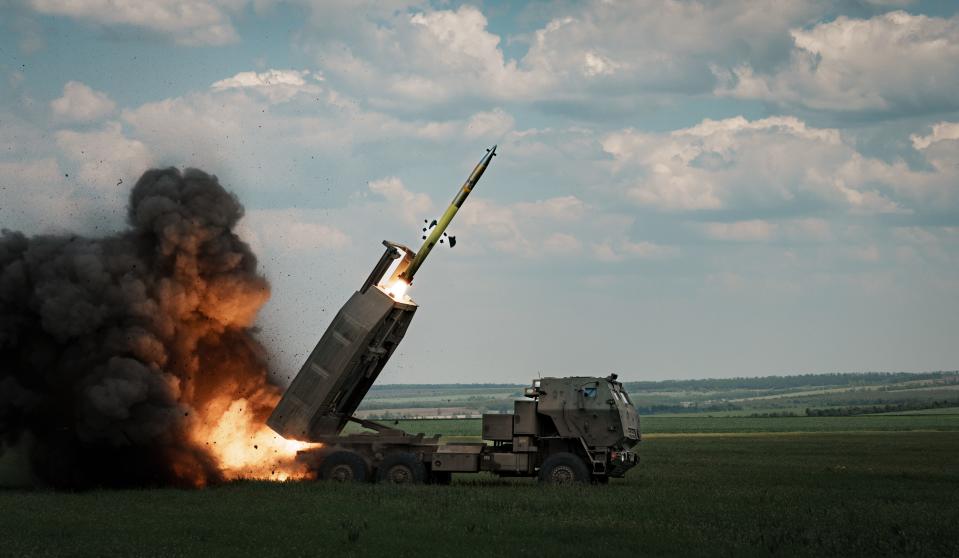Ukraine needs different weapons to blunt Russia's artillery fire advantages because HIMARS aren't enough anymore, war experts say
Ukraine is facing ammunition shortages, and its forces are being outgunned by Russia.
War experts say Kyiv will need more precision-guided munitions to blunt Moscow's advantage in artillery fire.
Western officials continue to warn that giving Ukraine more weapons and ammo is the "path to peace."
Ukrainian forces can't keep up with Russia's current rate of artillery fire and will need different weaponry if they want to try and blunt the enemy's edge in fires, war experts say, offering a suggestion that comes amid an increasingly grim battlefield outlook for Kyiv.
"Western-provided artillery ammunition in the future is unlikely to support a fire rate that exceeds Russia's," wrote Michael Kofman and Dara Massicot, experts with Carnegie Endowment for International Peace, and Rob Lee, an expert at the Foreign Policy Research Institute, in recent commentary for War on the Rocks.
Ukrainian forces are dealing with severe ammunition shortages and are being outgunned by Russia's military. This situation is a dramatic reversal from the one over the summer, when Kyiv was using artillery to pound Russian positions, and can be explained by increased production in Russia and the acquisition of North Korean weaponry.
By some estimates, the Ukrainians are now firing just 2,000 artillery rounds a day, while Russia is nearing daily totals of around 10,000 shells. The experts said Moscow's rate of fire will be sustainable next year "in excess of that number."

Kofman, Massicot, and Lee wrote in their article that "since Ukraine was unable to overcome Russia's defenses last summer with a quantitative advantage with artillery ammunition, the prospects for future offensives will be worse unless Ukraine and its supporters can compensate by developing other advantages."
"This means that the volume of artillery fire will have to be supplemented with drones and other precision strike capabilities in the future," the experts wrote.
Notably, Ukraine can no longer rely on its US-provided High Mobility Artillery Rocket System (HIMARS) or Excalibur artillery shells to diminish Russia's firepower, the experts said.
HIMARS quickly became highly revered when they first emerged on the battlefield in 2022 and as Kyiv used them to strike Russian positions and deny Moscow the ability to stage massive amounts of ammunition near the front lines and sustain a high rate of fire.
But by the following year, Russia had adapted to this problem and moved its high-value assets — like ammunition depots and logistics nodes — out of the HIMARS' range, reducing its effectiveness. The three experts suggested that given these adjustments, Ukraine's Western military backers may want to brainstorm new ways to blunt Moscow's rate of fire, a potential solution being more precision-guided munitions with range.
They also noted that improvements in Russia's electronic warfare capabilities have degraded the effectiveness of advanced GPS-guided munitions like HIMARS rockets or US-provided Excalibur shells, another dilemma that Kyiv's backers will have to address with future deliveries.

"The planning should not only evolve, based on the experience in 2023, but it should also be cognizant of the adaptations and technological innovation on the battlefield that could increase or offset those requirements," the experts wrote in their commentary.
Ukraine has received several effective precision-guided munitions from NATO members in 2023 and used them to wreak havoc on Russian assets. Kyiv's forces relied on UK- and France-provided Storm Shadow/SCALP-EG cruise missiles to batter Russia's Black Sea Fleet, and turned to US-provided MGM-140 Army Tactical Missile Systems, or ATACMS, to deliver a major blow to Moscow's helicopter fleet.
Ukraine only has a limited number of these kinds of weapons, and while it was recently promised a additional SCALP missiles by France, there has not been any confirmation of additional ATACMS strikes — or deliveries of the munition — since last fall.
As the future of US security assistance to Ukraine remains uncertain, with additional funding held up by Republican lawmakers, Western officials continue to signal that a stoppage in military aid may lead to catastrophic consequences in the near future.
"If we want a lasting, just peace, we must provide Ukraine with more weapons and ammunition," NATO Secretary Jens Stoltenberg said during a joint press conference this week with US Secretary of State Antony Blinken. "Weapons to Ukraine," he said, "is the path to peace."
Read the original article on Business Insider


